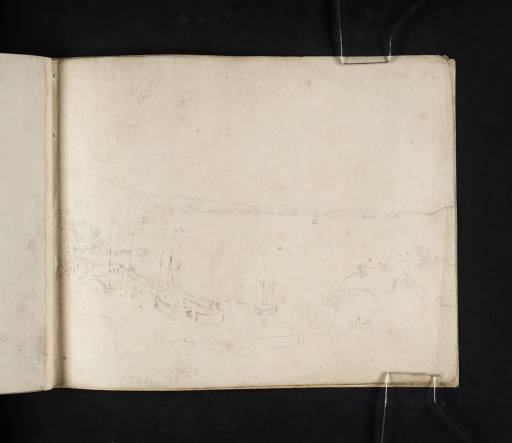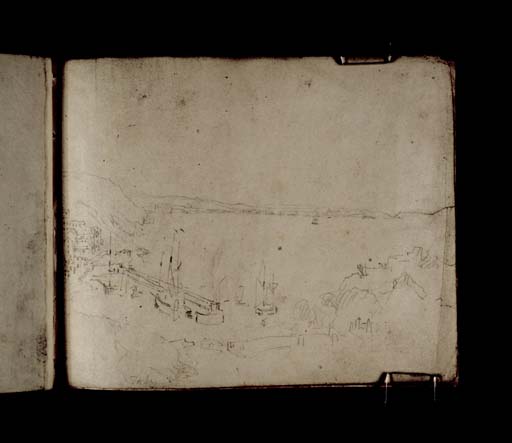Joseph Mallord William Turner Torbay from Brixham 1811
Image 1 of 2
Joseph Mallord William Turner,
Torbay from Brixham
1811
Joseph Mallord William Turner 1775–1851
Folio 48 Recto:
Torbay from Brixham 1811
D08863
Turner Bequest CXXIV 48
Turner Bequest CXXIV 48
Pencil on white wove paper, 170 x 209 mm
Inscribed by Turner in pencil ‘Torbay’ bottom left
Blind-stamped with Turner Bequest monogram bottom right
Stamped in black ‘CXXIV – 48’ bottom right
Inscribed by Turner in pencil ‘Torbay’ bottom left
Blind-stamped with Turner Bequest monogram bottom right
Stamped in black ‘CXXIV – 48’ bottom right
Accepted by the nation as part of the Turner Bequest 1856
References
1909
A.J. Finberg, A Complete Inventory of the Drawings of the Turner Bequest, London 1909, vol.I, p.354, CXXIV 48, as ‘“Torbay” from Brixham’.
1975
Malcolm Cormack, J.M.W. Turner, R.A. 1775–1851: A Catalogue of Drawings and Watercolours in the Fitzwilliam Museum, Cambridge, Cambridge 1975, pp.40, 41 note 2 under no.13.
1979
Andrew Wilton, J.M.W. Turner: His Life and Work, Fribourg 1979, p.353 under no.468.
1981
Eric Shanes, Turner’s Rivers, Harbours and Coasts, London 1981, pp.26 under no.34, 152.
1990
Eric Shanes, Turner’s England 1810–38, London 1990, p.59 under no.35.
2005
Arthur Ebdon, Turner in Teignmouth, Toby Thorne (ed.), Teignmouth 2005, p.16.
Turner’s view is from above King’s Quay on the south-east side of Brixham Harbour, at about the point where King Street becomes Berry Head Road;1 for Berry Head itself, see the Devonshire Coast, No.1 sketchbook (Tate D08557; Turner Bequest CXXIII 99a). Today the best equivalent for the viewpoint is the east end of North View Road, set back above King Street, looking north-west along the curving coast of Torbay, with Paignton on the west side and Torquay on the north, terminating at Hope’s Nose about five miles across the water. Presumably as preparation for his West Country tour, Turner had noted in the Vale of Heathfield sketchbook: ‘Torbay 12 miles from Hopes nose to Berry head | Brixham where William 3 landed 5 Novr 1688’ (Tate D40864; Turner Bequest CXXXVII inside front cover). These facts come from John Feltham’s Guide to All the Watering and Sea-Bathing Places (revised edition, London 1810, p.427).
The recently built New Pier is seen below, running eastwards from the Quay. It was later extended with an arm northwards at right-angles from its end and an additional pier was added beyond, effectively forming a self-contained second harbour. Other significant changes include the building of a breakwater over half a mile in length,2 which, superimposed on Turner’s composition, would end at about the centre and run in a shallow diagonal towards the bottom right.
Finberg notes that this sketch is the basis for the watercolour Tor Bay, from Brixham of about 1816–17 (Fitzwilliam Museum, Cambridge),3 engraved in 1821 for Picturesque Views on the Southern Coast of England4 (see the concordance of the series in the 1811 tour introduction). There are also two small sketches of Brixham in Devonshire Coast, No.1 (Tate D08466, D08470; Turner Bequest CXXIII 53a and 55a). The first of these shows only a profile of the distant coast, but also includes a note apparently reading ‘Cloathn dry’ in the foreground, prompting the addition of women with laundry at that point in the watercolour. The second is a superficially similar study of the harbour, actually made from further west and including the Eastern Quay, an older, shorter pier within the harbour south of the King’s Quay; William Daniell’s aquatint of Brixham for A Voyage Round Great Britain, published in 1825 (Tate impression: T02994), shows the same view. The Eastern Quay is not visible in the present drawing, as it stands just beyond the left-hand edge of the composition.
Although the future King William III landed at Brixham during the ‘Glorious Revolution’, Turner’s oil painting The Prince of Orange, William III, Embarked from Holland, and Landed at Torbay, November 4th, 1688, after a Stormy Passage, exhibited in 1832 (Tate N00369)5 is a sea piece, with no indication of the coast.
Turner labelled this sketchbook ‘Corfe to Dartmouth’. The present sketch is the last in it, although Dartmouth is further south (see folios 46 recto, 47 recto; D08861, D08862); he appears to have turned north-east to Brixham before heading west and beginning afresh in the Ivy Bridge to Penzance sketchbook (Tate; Turner Bequest CXXV).
‘The Brixham Harbour & Breakwater’, Caught in the Web: Bytes of Torbay’s Past, accessed 16 October 2008, http://www.torbytes.co.uk/op/tm7/lv2/item1420.htm .
Finberg 1909, I, p.354; see also Cormack 1975, pp.40, 41 note 2; Wilton 1979, p.353; Shanes 1981, pp.26, 152; and Shanes 1990, p.59; see also Shanes, J.M.W. Turner: The Foundations of Genius, exhibition catalogue, Taft Museum, Cincinnati 1986, p.50 under no.31.
Technical notes:
The page is darkened and rubbed overall. A tear and creasing to the right-hand edge have been reinforced from the verso.
Verso:
Blank, save for inscriptions by John Ruskin in red ink ‘1’ bottom left upside down, and faint ‘639’ in the same corner the right way up.
Matthew Imms
February 2011
How to cite
Matthew Imms, ‘Torbay from Brixham 1811 by Joseph Mallord William Turner’, catalogue entry, February 2011, in David Blayney Brown (ed.), J.M.W. Turner: Sketchbooks, Drawings and Watercolours, Tate Research Publication, December 2012, https://www


